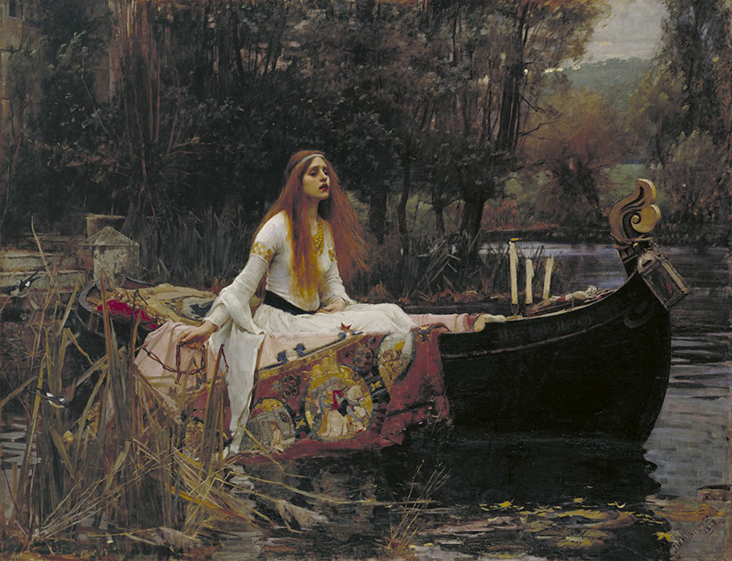FS Colour Series: Wildcherry inspired by John William Waterhouse’s Crushed Romance
With the heady richness of crushed blackberries or port red wine, WILDCHERRY linen’s tart shade of burgundy stained deep into the canvases of Pre-Raphaelite painter John William Waterhouse, lending them the dramatic intensity of a stormy romance. Brooding, tragic heroines fill his paintings, carrying an air of wistful, melancholic longing as their long hair and draped clothes trail behind them, conjuring up the medieval Romanticism and enigmatic symbolism that defined the Victorian era. Art historian Peter Trippi writes, “Waterhouse’s art … reflects a lifelong fascination with the Romantic and Symbolist themes of passion, magic and transformation, spiritual, erotic and physical…”
Waterhouse was born in Rome, the son of two English painters, who affectionately named him ‘Nino.’ He remained in Italy for the early stages of his childhood but by the mid-1950s the family had moved on to London in search of a new life. When Waterhouse’s mother died he was still a young boy, but he took up work assisting in his father’s studio, which cemented in him a love of the arts. Determined to become a painter, he joined London’s Royal Academy School in 1871.
In his early paintings Waterhouse captured biblical and classical themes, portraying figures set amongst ancient palaces and temples, revealing an early inclination towards the weight and symbolism of history. Towards the 1880s he had shifted into literary subjects as influenced by the Pre-Raphaelite Brotherhood, painting scenes lifted from Greek mythology and Arthurian legend. Many captured women as the central character, whose appearance echoed the Pre-Raphaelite archetype who was pale, lofty and independent, a new muse for a new era, which caused shock amongst the British art establishment.
Waterhouse’s most iconic painting is The Lady of Shalott, 1888, based on an excerpt of Tennyson’s famous poem, published in 1832, in which the doomed heroine is trapped in an isolated tower under a curse, only able to view the world beyond her through a mirror. When she sneaks a glimpse at the handsome knight Sir Lancelot through the real window, she falls to the ground and drifts in a boat downstream, dying before reaching the knight’s palace. A potent metaphor for awakening sexuality and loss of innocence, Waterhouse’s interpretation envisions the Lady with deep, burgundy lips, as dark cherry tones fall into the fabric around her, nestling amongst soft greens in the dry grasses and foliage that surrounds her.
Made several years later, Waterhouse’s enchanting illustration of John Keats’ 1819 poem La Belle Dame Sans Merci, 1893, (The Beautiful Lady without Mercy) captures the poem’s temptress as a femme fatale dressed in rich, entrancing berry tones, one who ensnares a soldier with doe-eyed innocence and long tresses before inflicting on him a cruel fate.
Returning to the Lady of Shalott later in his career, Waterhouse painted an earlier scene from the fateful story of his favourite heroine, in I am Half Sick of Shadows said the Lady of Shalott, 1915. Here the Lady is seen while still trapped in her tower, gazing into a mirror while wearily longing for an escape. Arms stretched overhead are decorated in a dazzling shade of plum which encircles her face with heady depths of romantic longing, conflicting with a glistening shard of acid green grass outside.
Berry tones also fill Waterhouse’s depiction of the unfortunate Tristan and Isolde, 1916, a story lifted from Arthurian times in which two lovers are doomed from being together. Maroon and burgundy fall down Isolde’s draped clothing, contrasting sharply with her green robes suggesting the ache of her passion, while slashes of plum appear under Tristan’s steely armour, revealing the tender rawness of love and longing beneath.























































2 Comments
A B
One of my favorites! This is an artists who appreciated the beauty of women. His works keep the folk and our legends alive. I’ll have to buy this color linen now.
Vicki Lang
What a lovely rich color. The paintings of poetry brought to life. Thank you for bring such a lovely painter to the for ground.